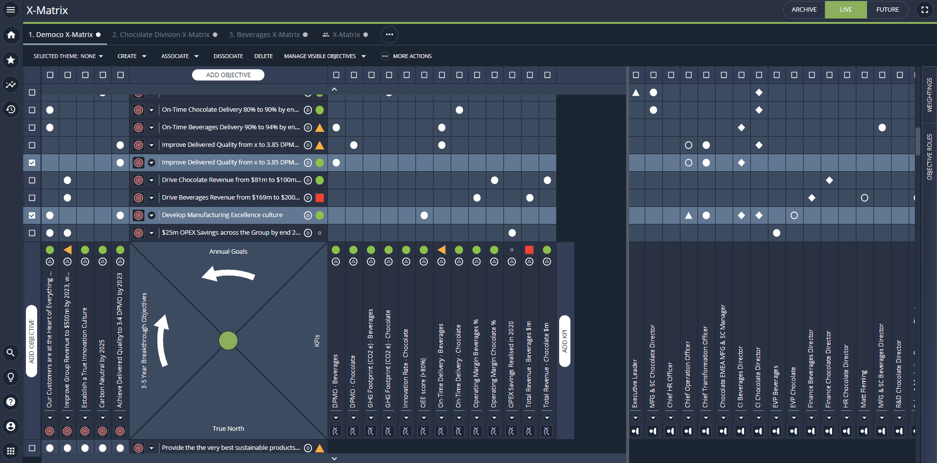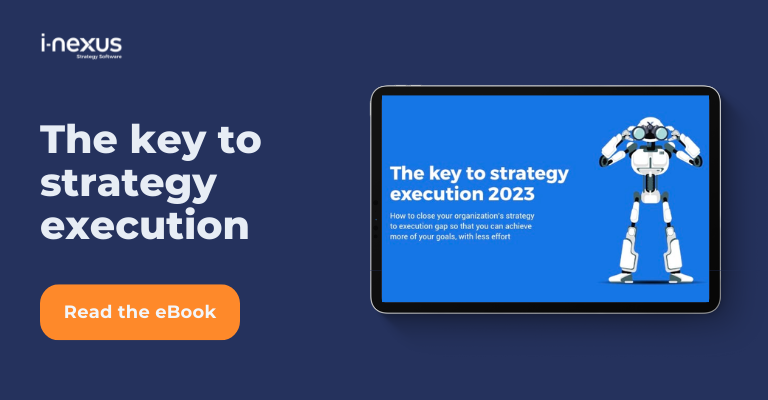There are lots of strategic planning tools available – but none more effective than the x-matrix. Here's why x-matrix planning is an effective way to create engagement, buy-in, and transparency in turning your plan into projects that deliver real value.
With so many options for building a strategic plan, we find ourselves being asked why they should use the x-matrix.
Equally eye-catching as overwhelming on first glance, the xmatrix approach to planning is our focus today.
Reviewing and building out the strategic plan – whether in October, January, or April - is a staple in the life of every planner. So too, is the increased pressure to build a robust, connected plan from the strategy to individual sites across the organization.
Here's why you should use the matrix in your planning cycles this year.
Why use a strategic planning tool?
The starting point has to be this. After all, why would you use any particular method of planning?
Much like a Project Manager turns to their trusted DMAIC, or a Marketing Manager follows their campaign basics, strategic planning is no different.
Seeking to take the corporate strategy and build out clear, achievable goals, strategic planners are required to walk the delicate line of setting long-term goals, short-term goals, improvement priorities, and a suite of portfolios, programs, and KPIs to boot.
The result is a great deal of mental work, coordinating different stakeholders across planning, sites, HR, and finance – and the hope is, with grace and fortune, the plan is both robust and capable of delivering the results needed.
What are the options?
As for the strategic tools and models available, these often rise to the top:
Models
The Balanced Scorecard (BSC)
A four-perspective view categorizes your goals, portfolios, and KPIs according to how they impact your Customer, Internal Processes, Organizational Capacity, and Finances. It often leads to a scorecard to visually manage the plan.
Objectives, Goals, Strategies, and Measures (OGSM)
A structured approach to strategic planning we’ve covered here, much like BSC, OGSM encourages you to create positive, concise statements of what you want to achieve and how you’ll do that.
Objectives and Key Results (OKR)
Focusing on the fast-paced delivery of objectives, OKRs would be set at an employee level, ensuring that objectives and metrics link back to the corporate strategy.
Hoshin Kanri (Policy Deployment)
Hoshin brings Lean thinking around continuous improvement and connects it to strategic goals, with x-matrix and bowler (metric) charts as the key tools.
Vision, Values, Methods, Obstacles, and Measures (V2MOM)
Championed by Salesforce, this approach is referred to as creating a ‘living, breathing document’ that focuses on empowering staff to execute and optimize their V2MOM plan as the year progresses, with real-time updates of the plan based on employee and management engagement.
Tools
SWOT and PESTLE
The classic tools for assessing your environment this is the foundation for any plan.
VRIO Framework
VRIO helps you to understand the internal resource and skills at your exposal, which is vital for forecasting your portfolio’s projects and assigning the right people.
Gap Analysis
Either used pre-kick-off of the strategy or reviewing progress, as CIO explains, this method assesses the performance of a part of the business (product line / site / plant) to show performance to date against set goals.
What are the challenges?
Notice that these tools and models fail to provide a clear, source of truth for your strategic plnning.
That tool should give you a map of:
- Vision and Mission
- Long term goals
- Short term goal
- Improvement Priorities
- Portfolios and Themes
- Programs and Projects
- KPIs and Owners
And here, we begin to see the frequent challenges around strategic planning tools.
While it is important to have the buy-in of your team when setting goals for the team / unit / product line (i.e. OKRs), and strategic themes to follow (i.e. OGSM), it falls apart when the reality kicks in with executing strategy.
The key is to find a planning tool that covers the full matrix of the strategy.
That means balancing goals, people, resources, and performance – and making reality clear so that decisions can be made with the necessary data.
That is where x-matrix planning comes in.
How does the x-matrix support you?
While commonly linked to the Hoshin Kanri strategic planning model, the x-matrix can be created and managed outside and combined with any approach that you see fit.
And that is the beauty of the matrix – it affords you the transparency, structure, and support to focus on building a robust plan, executing according to that path, then measuring and pivoting as needed.
Here are four reasons organizations turn to the x-matrix:
Imagine creating a plan in isolation from your stakeholders. Or, at least, the competing interests from not only within your product line / site, but up and across the rest of the organization.
You experience that each day. However, with a matrixed planning approach, you can work together to set goals, and then build a coherent list of priorities that need to be tackled each year.
When using something like the catchball process, you can collaborate in how you form your goals.
That can be carried over into the x-matrix, too, with the tool allowing for multiple plans to be built, linked back to the corporate mission and vision.
With your entire strategic plan inside the x-matrix, you can then zoom out and look at the complete picture.
That’s because the x-matrix shows you:
Long Term Goals
Breakthrough Objectives, covering 3-5 year goals
Short Term Goals
Annual Objectives which aim to move you towards your Breakthroughs
Improvement Priorities
AKA strategic portfolios (themes of activities) which consist of programs / projects to deliver in order to hit your Annual Objectives
Targets
The goals for the Breakthroughs, Annuals, Improvement Priorities, and
Accountable Owners
Stakeholders / resources responsible for delivery of Breakthrough, Annual, or Improvement Priority
And that creates transparency in your plan.
For example, in this x-matrix, you can see (via the tick boxes and highlighted lines) that the Chief Transformation Officer has two annual goals that they are a resource for:
i. Developing a Manufacturing Excellence culture
ii. Improving Delivered Quality from x to 3.85 DPMO

The i-nexus x-matrix shows resource dependencies against goals
This matrix demonstrates the full scale of interdependencies of your strategic plan.
Here, the CTO will be involved in several key efforts alongside the COO and CI Beverages Director.
This visibility lets you know there is a delivery risk around the level of input from the CTO and their availability for strategic work, alongside balancing their business-as-usual tasks.
It is with this information that you can then begin to introduce tools to ringfence resources and build out contingencies for when the CTO is unable to support them.
This theme continues throughout the x-matrix.
3) Beyond planning
The x-matrix helps you beyond the planning phase of your strategy.
While the plan is the start of the deployment journey, it is execution where the x-matrix shines.
The matrix is the single source of truth for your performance, connecting:
- Strategic portfolios to programs and prioritization criteria
- Strategic programs to projects around Continuous Improvement
- Course corrections post root cause analysis via Action Plans and A3 countermeasure reports
- Performance reviews around KPIs with team journals, combining data with narrative
When adopting x-matrix software like i-nexus, you can connect the x-matrix to all of the above and automatically populate the KPI bowling chart – which is often a time-consuming effort – giving you an end-to-end view of the strategy’s execution.
4) Structure and rigor
Finally, because the x-matrix is associated with Hoshin Kanri – which links Lean management to strategy – the x-matrix is inherently part of a more structured, disciplined approach to strategic planning and strategy execution.
That is not to say that the x-matrix is a laborious process.
In fact, with the right support, in the form of software, you can build an x-matrix that serves your entire organization.
From planning to strategy delivery, and review, the matrix becomes more effective and easier with increased usage.
The x-matrix, and its associated tools, such as the KPI bowler and A3 metric sheet, combined with the 7 steps of Hoshin planning, encourage you to regularly update and review your approach (which V2MOM borrows from) – the very discipline and agility required in the 2020s.

Planning Managers discuss strategic goals for the year
Be wary…
The x-matrix provides you with a fresh, structured approach to planning and much more.
However, this overview would be incomplete covering what you can use to build the x-matrix.
Your options are two fold.
There are many templates available to you when it comes to the x-matrix, such as our own, which comes with advice on how to fill it in.
It is entirely plausible to start off with a matrix template. After all, they are built with Excel, can be used within Google Sheets, and generally give you a taste of building your own.
This can then be reported on and managed via email and templates.
The glue to connect all these items, however, would be manual intervention with something like a Trello board or OneDrive. This is, in all actuality, the biggest challenge facing x-matrix users.
2) X-matrix software
On the other hand, you have purpose-built x-matrix software, such as i-nexus:
Whilst it won’t be a surprise that we recommend a software solution for your x-matrix, there is a very good reason for that.
If you are looking to make the management of the matrix easy and connected to KPI charts and metric graphs, let alone across your whole business, the software is the right choice.
And, it’s easy to build your x-matrix in i-nexus, as we cover below:
The weakness of the x-matrix is, after all, the administrative burden it creates as you build more plans and spread the method across the organization.
That is when your Planning Managers fall into the failings of spreadsheets, and ultimately, it will derail your plan.
Get more from the x-matrix
Click here for further information on Hoshin Kanri, or continue your journey with these recommendations:
- The complete Hoshin Kanri Excel template pack: Download our x-matrix, bowling chart, action plan, and root cause analysis Excel template and PDF guide pack.
- Hoshin Kanri - OGSM - OKR: a case of apples and oranges?: Uncover the similarities between Hoshin Kanri, OGSM, and OKR in our comparison eBook.
- Digitalize your x-matrix: We all know the shortcomings of x-matrix Excel sheets, but how can you break through and achieve a true step-change in your Hoshin planning and execution? Enter the i-nexus x-matrix and this 30-minute webinar.
About the author
James Milsom is Head of Marketing at i-nexus. James has wide-ranging experience in markets such as telecommunications, energy, education, and software.
As Head of Marketing, he aims to raise awareness and understanding of enterprises' challenges in delivering strategic objectives and transformation amidst changing markets and the obstacles traditional tools and methods present leaders.
If you’d like to talk more about strategy execution, reach out to James at james.milsom@i-nexus.com or connect with him on LinkedIn for the latest insights.





.jpg?width=352&name=seminar-594125_1920%20(1).jpg)